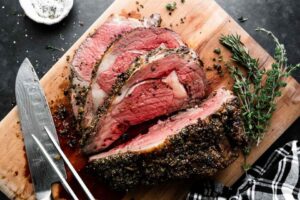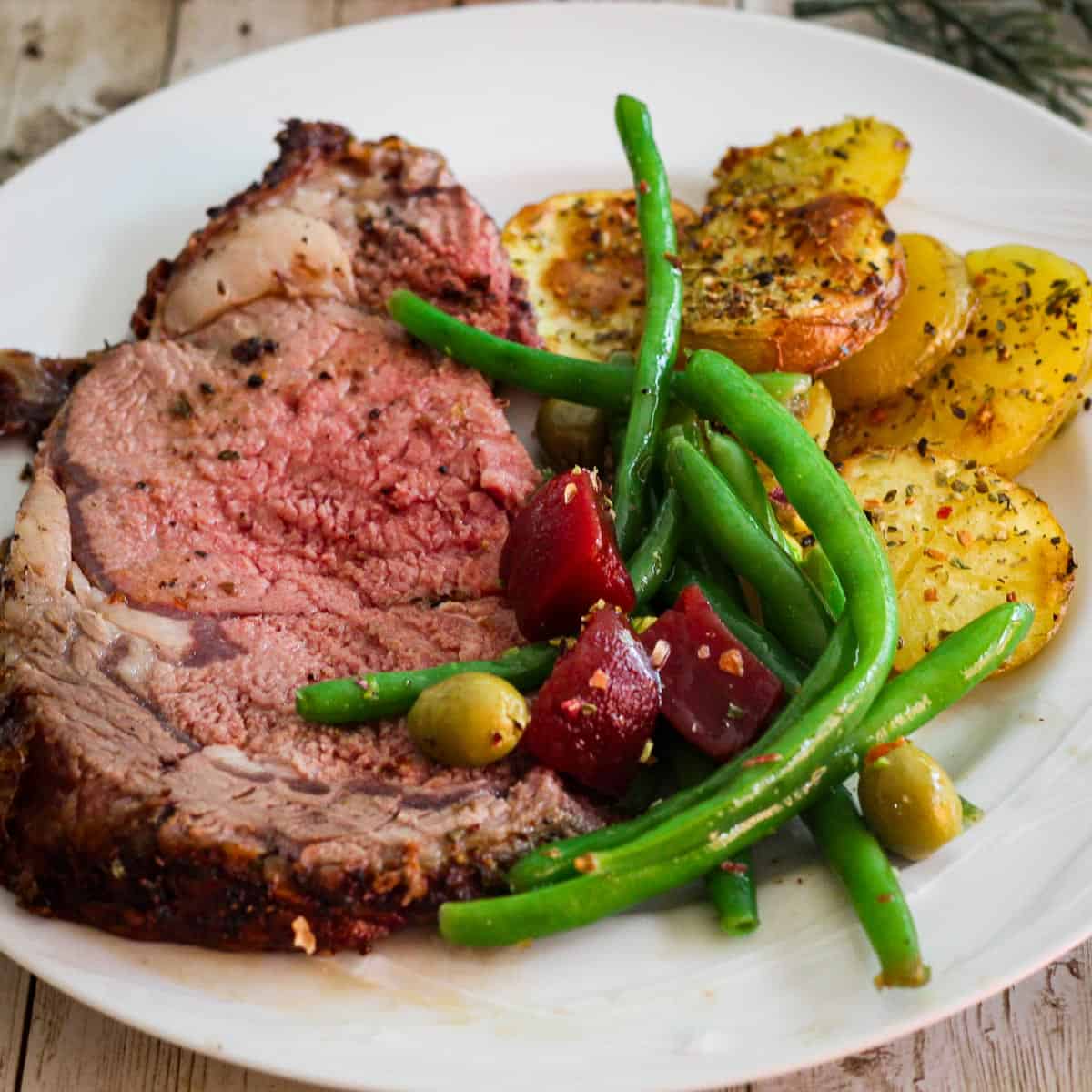2–3 Tbsp olive oil or melted butter
Kosher salt, generous quantity
Freshly ground black pepper
4 garlic cloves, minced
2 Tbsp fresh rosemary, chopped
2 Tbsp fresh thyme leaves
Optional: beef broth or red wine for jus
Optional: whole grain mustard or horseradish sauce for serving

Instructions
Step 1: Prep & Season
-
If time allows, the night before cooking, dry‑brine the roast: pat it dry, rub with salt and pepper, place on a rack uncovered in the fridge. According to serious‑cooking guides, dry‑brining large roasts enhances flavor and surface browning. Serious Eats
-
On the day, remove the roast from the fridge ~1–2 hours ahead of cooking to come to near room temperature.
-
Pre‑heat your oven or set up your roasting/roast zone.
-
Rub the roast with olive oil or melted butter, then evenly coat with garlic, rosemary, thyme, salt and pepper.
Step 2: Slow Roast
-
Place the roast fat‑cap side up on a V‑rack in a roasting pan (so air can circulate). Many chefs recommend starting at a low temperature (250‑300 °F) to minimize over‑cooked edges. Striped Spatula+1
-
Roast until the internal temperature (inserted into the center, away from bone) reaches your target:
-
120‑125 °F for rare
-
130‑135 °F for medium‑rare
-
140‑145 °F for medium
Note: Expect 1¼‑1½ lb per person for bone‑in. Serious Eats
-
-
Remove the roast from the oven, tent loosely with foil, and allow to rest for 15‑30 minutes. Resting lets the juices redistribute and the internal temperature carry‑over a few degrees.
Step 3: Final Sear (Optional but recommended)
-
For a crusty exterior, either increase oven to 500 °F and return roast for 5‑10 minutes or sear in a hot skillet or grill briefly just before carving. According to experts, searing at the end helps minimize the gray ring and maximize crust. Serious Eats+1
-
Once rested and seared (if using), carve between the bones into thick slices and arrange on a warmed platter.
Step 4: Serve
-
Serve generous portions (˜½ – 1 lb per person). Offer horseradish sauce or mustard, and drippings/au jus if desired.
Tips for Success
-
Use a reliable instant‑read thermometer: Don’t guess your doneness.
-
Let meat rest uncovered in fridge if dry‑brining: This helps the surface dry out for better crust.
-
Calculate size properly: Estimate ¾‑1 lb per person for bone‑in. Serious Eats
-
Keep oven door closed during slow roast to maintain consistent temperature.
-
Rest adequately: The internal temperature will rise ~5 °F during resting; cutting too early causes juices to drain. Southern Living
-
Save drippings: Use pan drippings and bones to make a robust au jus.
Variations
-
Herb‑crusted prime rib: Mix chopped rosemary, thyme, garlic, and coarse salt as a rub.
-
Mustard seed crust: Coat roast with Dijon and mustard seeds for a textured crust. Bon Appétit
-
Smoked prime rib: Use a smoker at ~250 °F with mild woods like cherry or oak for extra flavor. The Spruce Eats
-
Boneless version: If you prefer ease of carving, ask your butcher for a boneless rib roast and adapt same method.
Ingredient Substitutions
-
Bone‑in vs boneless: Bone adds flavor and presentation; boneless is easier to carve.
-
Butter vs olive oil: Butter adds richness; oil is lighter and smokers may prefer it.
-
Seasonings: Feel free to add smoked paprika, mustard powder or Worcestershire sauce to the rub.
-
Grade of beef: USDA Prime grade has more marbling, but Choice grade can be excellent if cooked properly. Striped Spatula
Storage & Reheating
-
Storage: Let leftovers cool slightly, then store in airtight containers in fridge up to 3‑4 days.
-
Reheating: Pre‑heat oven to 250 °F, place slices in pan with a splash of beef broth or drippings, cover with foil and warm for ~20‑30 minutes to just below serving temp. Avoid microwave that dries meat.
-
Leftovers: Ideal for hearty sandwiches, beef hash or sliced in omelettes.
Serving Suggestions
Side Dishes
-
Creamy garlic mashed potatoes
-
Roasted root vegetables (carrots, parsnips, brussels sprouts)
-
Yorkshire puddings or dinner rolls
-
Rich gravy or au jus made from drippings
Drinks
-
Full‑bodied red wine (Cabernet Sauvignon, Bordeaux, Syrah)
-
Dark ale or stout for beer lovers
-
Sparkling cider or crisp white for non‑alcoholic alternative
Nutrition Facts (Estimate per 8 oz serving of roast only)
-
Calories: ~600 kcal
-
Protein: ~45 g
-
Fat: ~45 g (depends on marbling)
Note: These are approximate values and depend heavily on cut and trimming.
FAQs
Q: How do I know if prime rib is done?
A: Use an instant‑read thermometer: 120‑125 °F rare, 130‑135 °F medium‑rare, 140° F+ for medium. Remove early, as it will carry over a few degrees. Serious Eats
Q: Do I need to tie the bones?
A: Tying keeps the roast compact and helps even cooking. Some butchers “roll and tie” the bones for easier carving. Food & Wine
Q: Should I sear before roasting?
A: While common, expert tests show reverse‑searing (roasting low then searing/high) gives more even doneness and less over‑cooked edges. Serious Eats+1
Q: Why is there a gray band around my roast?
A: That’s over‑cooked meat from using too high initial heat. Slow and low roasting or reverse‑searing reduces the gray zone. Serious Eats
Related Recipes
Conclusion
A prime rib roast is more than a dish—it’s a statement. From the dramatic bone‑on presentation and thick juicy slices to the deep marbling and rich flavor, it’s the roast that says “celebration.” When cooked with care—slowly, seasoned smartly and rested properly—you’ll serve slices that are tender, flavorful, and generous. Whether it’s a holiday table, special dinner or anytime you want to impress, this roast delivers. Gather your guests, carve with confidence and savor every generous portion.

